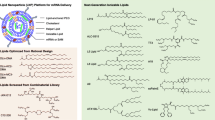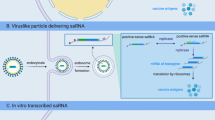Abstract
As a vaccine vector, Listeria monocytogenes targets the innate immune system, resulting in a cytokine response that enhances antigen-presenting cell function as well as inducing a Th1 profile. It also enhances cell-mediated immunity by targeting antigen delivery in antigen-presenting cells to both the MHC class I pathway of exogenous presentation that activates CD8 T cells and the MHC class II pathway that processes antigen endogenously and presents it to CD4 T cells. In this review, we describe the development of vaccine constructs that target the human papillomavirus 16 (HPV-16) E7 antigen, and we characterize their effects on tumor regression as well as various immune parameters both innate and adaptive. In particular, we describe the effect on tumor angiogenesis, induction of antitumor suppressor factors like CD4+CD25+ T cells and regulatory cytokines TGF-β and IL-10, homing and infiltration of antigen-specific CD8+ T cells to the tumor, and also effects of the vaccines on antigen-presenting cells, especially focusing on dendritic cell maturation and ability to influence tumor regression. We believe that the identification of several immune parameters that correlate with antitumor efficacy, and of some that have a negative correlation, may have wider application for other cancer immunotherapeutic approaches.









Similar content being viewed by others
References
Carreno BM, Collins M (2002) The B7 family of ligands and its receptors: new pathways for costimulation and inhibition of immune responses. Annu Rev Immunol 20:29–53
Crum CP, Rivera MN (2003) Vaccines for cervical cancer. Cancer J 9:368–376
Gunn GR, Zubair A, Peters C, Pan ZK, Wu TC, Paterson Y (2001) Two Listeria monocytogenes vaccine vectors that express different molecular forms of human papilloma virus-16 (HPV-16) E7 induce qualitatively different T cell immunity that correlates with their ability to induce regression of established tumors immortalized by HPV-16. J Immunol 167:6471–6479
Gunn GR, Zubair A, Paterson Y (2002) Harnessing bacteria for cancer immunotherapy. In: Goebel W, Dietrich G (eds) Vaccines: delivery systems, chap 14. Horizon Scientific Press, Wymondham
Kiessling R, Wasserman K, Horiguchi S, Kono K, Sjoberg J, Pisa P, Petersson M (1999) Tumor-induced immune dysfunction. Cancer Immunol Immunother 48:353–362
Levey DL, Srivastava PK (1996) Alterations in T cells of cancer-bearers: whence specificity? Immunol Today 17:365–368
Lin KY, Guarnieri FG, Staveley-O’Carroll KF, Levitsky HI, August JT, Pardoll DM, Wu TC (1996) Treatment of established tumors with a novel vaccine that enhances major histocompatibility class II presentation of tumor antigen. Cancer Res 56:21–26
Liyanage UK, Moore TT, Joo HG, Tanaka Y, Herrmann V, Doherty G, Drebin JA, Strasberg SM, Eberlein TJ, Goedegebuure PS, Linehan DC (2002) Prevalence of regulatory T cells is increased in peripheral blood and tumor microenvironment of patients with pancreas or breast adenocarcinoma. J Immunol 169:2756–2761
Majewski S, Marczak M, Szmurlo A, Jablonska S, Bollag W (1996) Interleukin-12 inhibits angiogenesis induced by human tumor cell lines in vivo. J Invest Dermatol 106:1114–1118
Mata M, Paterson Y (1999) Th1 T cell responses to HIV-1 Gag protein delivered by a Listeria monocytogenes vaccine are similar to those induced by endogenous listerial antigens. J Immunol 163:1449–1456
Mata M, Travers PJ, Liu Q, Frankel FR, Paterson Y (1998) The MHC class I-restricted immune response to HIV-gag in BALB/c mice selects a single epitope that does not have a predictable MHC-binding motif and binds to Kd through interactions between a glutamine at P3 and pocket D. J Immunol 161:2985–2993
Mata M, Yao ZJ, Zubair A, Syres K, Paterson Y (2001) Evaluation of a recombinant Listeria monocytogenes expressing an HIV protein that protects mice against viral challenge. Vaccine 19:1435–1445
Onizuka S, Tawara I, Shimizu J, Sakaguchi S, Fujita T, Nakayama E (1999) Tumor rejection by in vivo administration of anti-CD25 (interleukin-2 receptor alpha) monoclonal antibody. Cancer Res 59:3128–3133
Pamer EG, Sijts AJ, Villanueva MS, Busch DH, Vijh S (1997) MHC class I antigen processing of Listeria monocytogenes proteins: implications for dominant and subdominant CTL responses. Immunol Rev 158:129–136
Pan ZK, Ikonomidis G, Lazenby A, Pardoll D, Paterson Y (1995) A recombinant Listeria monocytogenes vaccine expressing a model tumour antigen protects mice against lethal tumour cell challenge and causes regression of established tumours. Nat Med 1:471–477
Pan ZK, Ikonomidis G, Pardoll D, Paterson Y (1995) Regression of established tumors in mice mediated by the oral administration of a recombinant Listeria monocytogenes vaccine. Cancer Res 55:4776–4779
Pan ZK, Weiskirch LM, Paterson Y (1999) Regression of established B16F10 melanoma with a recombinant Listeria monocytogenes vaccine. Cancer Res 59:5264–5269
Peng X, Hussain SF, Paterson Y (2004) The ability of two Listeria monocytogenes vaccines targeting human papillomavirus-16 E7 to induce an antitumor response correlates with myeloid dendritic cell function. J Immunol 172:6030–6038
Portnoy DA, Chakraborty T, Goebel W, Cossart P (1992) Molecular determinants of Listeria monocytogenes pathogenesis. Infect Immun 60:1263–1267
Rosenberg SA, Yang JC, Schwartzentruber DJ, Hwu P, Marincola FM, Topalian SL, Restifo NP, Dudley ME, Schwarz SL, Spiess PJ, Wunderlich JR, Parkhurst MR, Kawakami Y, Seipp CA, Einhorn JH, White DE (1998) Immunologic and therapeutic evaluation of a synthetic peptide vaccine for the treatment of patients with metastatic melanoma. Nat Med 4:321–327
Schiller JT, Lowy DR (2001) Papillomavirus-like particle based vaccines: cervical cancer and beyond. Expert Opin Biol Ther 1:571–581
Seedorf K, Oltersdorf T, Krammer G, Rowekamp W (1987) Identification of early proteins of the human papilloma viruses type 16 (HPV 16) and type 18 (HPV 18) in cervical carcinoma cells. EMBO J 6:139–144
Sewell DA, Douven D, Pan ZK, Rodriguez A, Paterson Y (2004) Regression of HPV-positive tumors treated with a new Listeria monocytogenes vaccine. Arch Otolaryngol Head Neck Surg 130:92–97
Sgadari C, Angiolillo AL, Tosato G (1996) Inhibition of angiogenesis by interleukin-12 is mediated by the interferon-inducible protein 10. Blood 87:3877–3882
Sharpe AH, Freeman GJ (2002) The B7-CD28 superfamily. Nat Rev Immunol 2:116–126
Shimizu J, Yamazaki S, Sakaguchi S (1999) Induction of tumor immunity by removing CD25+CD4+ T cells: a common basis between tumor immunity and autoimmunity. J Immunol 163:5211–5218
Tindle RW, Frazer IH (1994) Immune response to human papillomaviruses and the prospects for human papillomavirus-specific immunisation. Curr Top Microbiol Immunol 186:217–253
Woo EY, Chu CS, Goletz TJ, Schlienger K, Yeh H, Coukos G, Rubin SC, Kaiser LR, June CH (2001) Regulatory CD4(+) CD25(+) T cells in tumors from patients with early-stage non-small cell lung cancer and late-stage ovarian cancer. Cancer Res 61:4766–4772
Acknowledgements
This work was supported by NIH Grant CA 69632 and ACS Grant TURSG LIB-01-168-01. We wish to thank past and current members of the Paterson laboratory, including Gregory Beatty, Mary Dominiecki, George Gunn, Zhen-Kun Pan, John Pappas, Duane Sewell, and Vafa Shahabi, for permission to describe their as-yet-unpublished results.
Author information
Authors and Affiliations
Corresponding author
Additional information
This article is a symposium paper from the second international conference “Strategies for Immune Therapy,” 29 February–3 March 2004, Würzburg, Germany; summarized by G. Pawelec and C. Gouttefangeas.
Rights and permissions
About this article
Cite this article
Hussain, S.F., Paterson, Y. What is needed for effective antitumor immunotherapy? Lessons learned using Listeria monocytogenes as a live vector for HPV-associated tumors. Cancer Immunol Immunother 54, 577–586 (2005). https://doi.org/10.1007/s00262-004-0600-2
Received:
Accepted:
Published:
Issue Date:
DOI: https://doi.org/10.1007/s00262-004-0600-2




